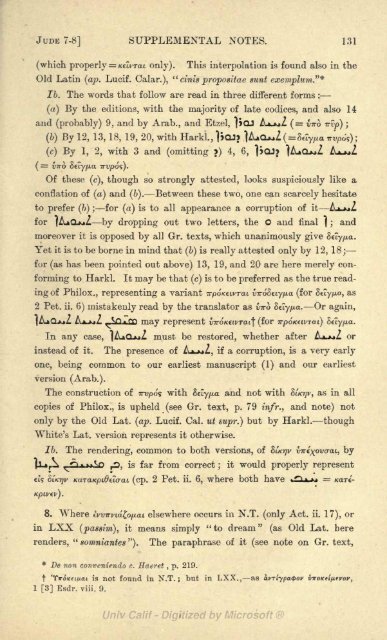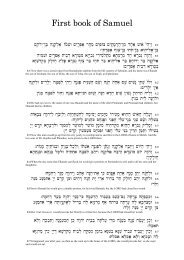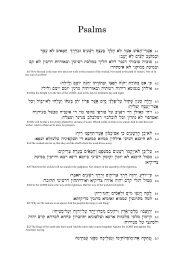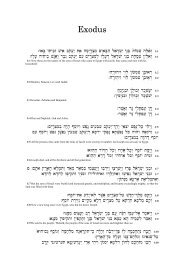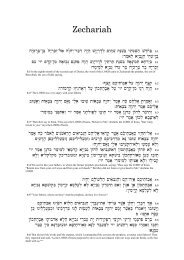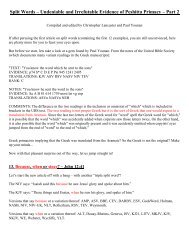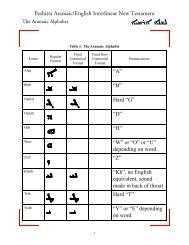ana translation
Untitled - Peshitta Aramaic/English Interlinear New Testament
Untitled - Peshitta Aramaic/English Interlinear New Testament
- No tags were found...
You also want an ePaper? Increase the reach of your titles
YUMPU automatically turns print PDFs into web optimized ePapers that Google loves.
JUDE 7-8] SUPPLEMENTAL XOTES. 131<br />
(which properly = KtvTai only).<br />
This interpolation is found also in the<br />
Old Latin (ap. Lucif. Calar.),<br />
" cinis propositae sunt exemplum."*<br />
Ib. The words that follow are read in three different forms :<br />
(a) By the editions, with the majority of late codices, and also 14<br />
and (probably) 9, and by Arab., and Etzel, ]jQJ<br />
A 7<br />
( = fao Trvp) ;<br />
(6) By 12, 13,18, 19, 20, with Harkl., 1>OJ> 1/UOwZ (<br />
= SeZ<br />
(c) By 1, 2, with 3 and (omitting >) 4, 6, 1>QJJ<br />
= ( VTTO Scty^Utt TTVpOs).<br />
Of these (c), though so strongly attested, looks suspiciously like a<br />
conflation of (a)<br />
and (6).<br />
Between these two, one can scarcely hesitate<br />
to prefer (b) for<br />
; (a)<br />
is to all appearance a corruption of it Aoj^Z<br />
for (AaQjsjZ by dropping out two letters, the O and final f ;<br />
and<br />
moreover it is opposed by all Gr. texts, which unanimously give Seiy/xa.<br />
Yet it is to be borne in mind that (b) is really attested only by 12, 18;<br />
for (as has been pointed out above) 13,<br />
19, and 20 are here merely conforming<br />
to Harkl. It<br />
may be that (c) is to be preferred as the true reading<br />
of Philox., representing a variant TrpoKeivrcu vTrdScty/xa (for Sety//.a, as<br />
2 Pet. ii. 6) mistakenly read by the translator as viro Sety/xa.<br />
Or again,<br />
f<br />
A^QjsjZ /UjaZ ^>ro ma y represent wroKCivratf (for Trpoicetnrai) Seiy/xa.<br />
In any case, (AjQjaZ must be restored, whether after A^j^Z or<br />
instead of it. The presence of A* *>/ if a corruption, is a very early<br />
one, being common to our earliest manuscript (1)<br />
and our earliest<br />
version (Arab.).<br />
The construction of Trvpo's<br />
with Sely/xa<br />
and not with SIK^V, as in all<br />
copies of Philox., is upheld (see Gr. text, p. 79 m/r., and note) not<br />
only by the Old Lat. (ap. Lucif. Cal. ut supr.) but by Harkl.<br />
White's Lat. version represents it otherwise.<br />
though<br />
Ib. The rendering, common to both versions, of Si'/o/v vWxoucrat, by<br />
s far from correct ;<br />
it would properly represent<br />
(cp. 2 Pet. ii. 6, where both have<br />
8. Where Ivv-irvid&p.a.i elsewhere occurs in N.T. (only Act. ii. 17), or<br />
in LXX (passim), it means simply "to dream" (as Old Lat. here<br />
renders, " somniantes ").<br />
The paraphrase of it (see note on Gr. text,<br />
* De non conveniendo c. Haeret , p. 219.<br />
t "TiroKei/nai is not found in X.T. ;<br />
but in LXX., as avri-ypaQov viroKfipfvov,<br />
1 [3] Esclr. viii. 9.


